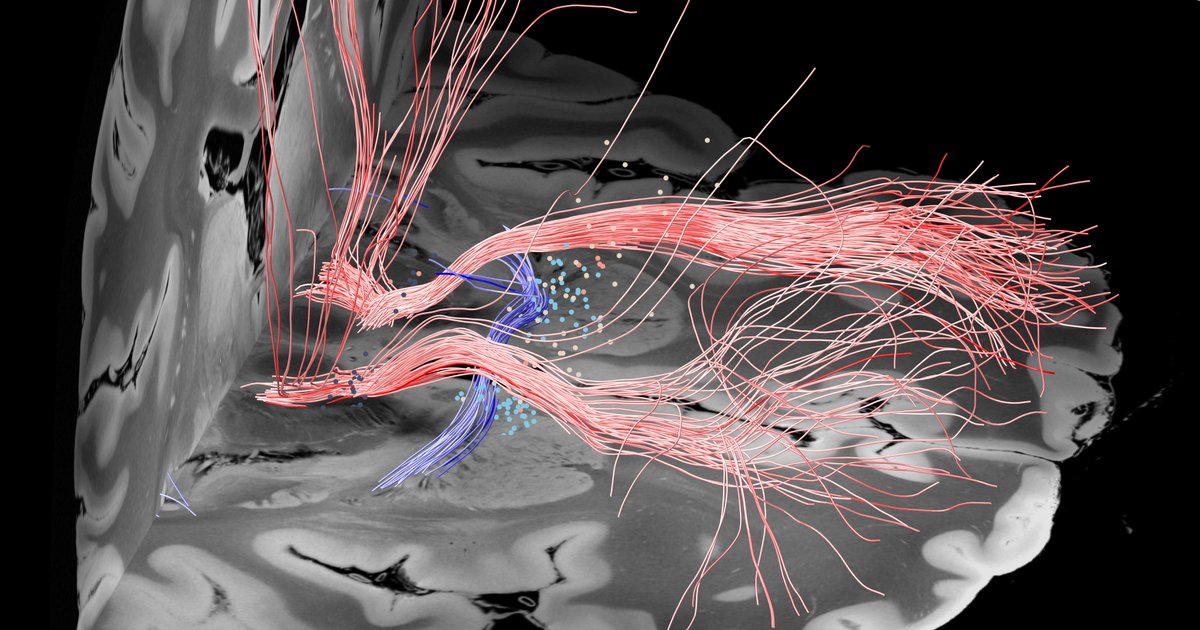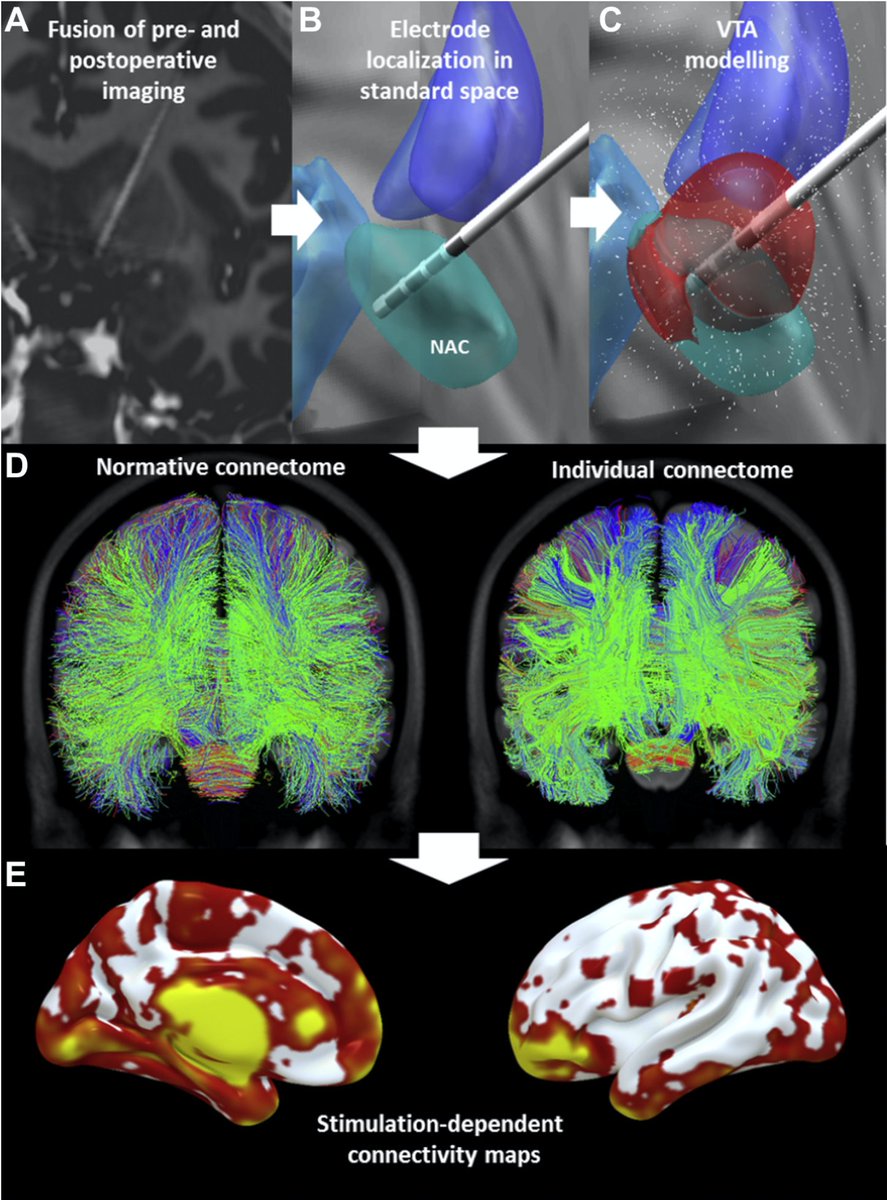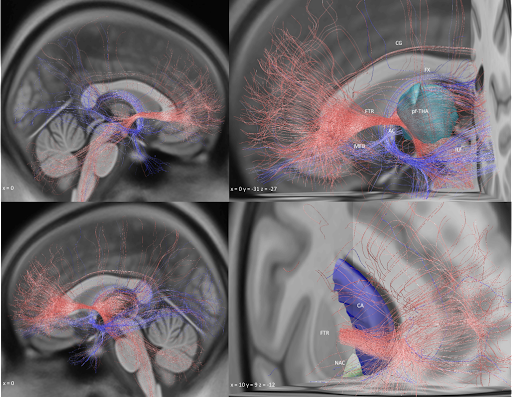
Delighted to share our review on connectomic DBS for OCD spearheaded by @BaldermannJC out in @BiologicalPsyc1 now. This is likely the most significant clinical-translational achievement I've had the privilege to play a part in, yet.
biologicalpsychiatryjournal.com/article/S0006-…
A thread:🧵
biologicalpsychiatryjournal.com/article/S0006-…
A thread:🧵

It all started in Cologne ~2018 where @BaldermannJC was the first to use the novel DBS fiberfiltering technique we had developed for @leaddbs on a dataset of 22 persons with OCD that underwent DBS in their center. 

This was published in @BiologicalPsyc1, as well (biologicalpsychiatryjournal.com/article/S0006-…) and among other cool things, @BaldermannJC identified a specific tract bundle within the central anterior limb of the internal capsule (ALIC) that associated with optimal improvement following DBS. 

Back in Berlin, same time, @NingfeiL applied fiber filtering on a cohort of OCD patients with STN-DBS graciously shared by the Grenoble team (M. Polosan, A. Kibleur & S. Chabardes). Serendipitously, it seemed like we identified the exact same tract! ALIC left, STN right: 

Ningfei could demonstrate that you could calculate the tract bundle exclusively on data from one target (e.g. ALIC) and use it to cross-predict outcomes in the other target (e.g. STN), and vice versa – could be as a first cross-target connectomic DBS cross-valudation. 

I presented these results at a DBS conference, where the London team was present (@HarithAkram, Ludvic Zrinzo) and w/ Eileen Joyce agreed to share data on 6 patients operated to BOTH targets which @himanshutyagi had published also in @BiologicalPsyc1
biologicalpsychiatryjournal.com/article/S0006-…
biologicalpsychiatryjournal.com/article/S0006-…
Calculating the tract on Grenoble (STN) and Cologne (ALIC) cohorts combined led to a more refined version of it which we used to cross-predict clinical improvements in the 6 patients of the London cohort. 

Around the same time, @SvenjaTreu from the @The_Strange_Lab in Madrid did a lab-rotation in our lab in Berlin and replicated main results on data from eight patients with ALIC DBS operated by Juan Barcia. 

Luckily, we were able to probe the tract target on yet another dataset to include in @NingfeiL's paper: Amazing in the Madrid cohort is that each contact level on 3391 (7 mm spacing!) electrodes had been probed each for three months, scanning through the ALIC ventral to dorsal: 

Finally, @NingfeiL's efforts were published at @NatureComms. But by then (it took at > 1 year), we had several iterations of preprints out showing these incremental results as outlined above. nature.com/articles/s4146…
By then, word had caught on and we had openly released the DBS tract target as a 3D atlas within @leaddbs, apparently catching the attention of the team at @MountSinaiDBS with @martijnfigee and @smithandrewh. 

Within 6 months time, they validated @NingfeiL's results by overlaying stimulation volumes of 10 additional patients from NYC to the tract and correlating the overlap with clinical outcomes, published in @brainstimj:
brainstimjrnl.com/article/S1935-…
brainstimjrnl.com/article/S1935-…

…nearly coinciding with a report by Tim van der Vlis, Linda Ackermans and Albert Leentjens, replicating the tract from scratch using 8 patients from Maastricht using @leaddbs – published in @JNeuromod:
onlinelibrary.wiley.com/doi/full/10.11…
Ours (left) vs. theirs (right) & LOOCV results:

onlinelibrary.wiley.com/doi/full/10.11…
Ours (left) vs. theirs (right) & LOOCV results:


A bit later, @DrPhilipMosley & Peter Silburn published an amazing randomized controlled trial in with OCD DBS to the bed nucleus – which is quite far from @NingfeiL's tract.
nature.com/articles/s4139…
nature.com/articles/s4139…

They found additional connections which are really exciting but in their results, it looked as if @NingfeiL's tract would also appear. 

…so @DrPhilipMosley agreed to put it to a test:
Overlapping the stimulation sites with @NingfeiL's tract again positively associated (albeit nonsignificantly) with clinical outcomes in these nine OCD patients with DBS to the bed nucleus.
Overlapping the stimulation sites with @NingfeiL's tract again positively associated (albeit nonsignificantly) with clinical outcomes in these nine OCD patients with DBS to the bed nucleus.

Finally, the potentially coolest result was calculated by @karaannjohnson and @butsonc in their amazing Tourette's DBS paper at @BiolP CCNI. Tourette's patients often have comorbid obsessive compulsive behavior (OCB) which changes after DBS.
sciencedirect.com/science/articl…
sciencedirect.com/science/articl…

In their report, they could show that the degree of overlap in these 28 DBS patients operated with target GPi and @NingfeiL's tract significantly correlated with clinical improvement of obsessive compulsive behavior – suggesting transdiagnostic utility of the target! 

Now while this is all great and it really seems a specific tract could be helpful in treating OCD by means of DBS – how does this map to distributed brain networks?
Enter @b_hollunder who together with @NingfeiL looked at this using DBS network mapping.
Enter @b_hollunder who together with @NingfeiL looked at this using DBS network mapping.

DBS network mapping is a method we developed w/ @foxmdphd by harnessing large-scale normative connectomes and probing connectivity to which areas could be associated with clinical response.
While a common pattern emerged, STN vs. ALIC DBS zones mapped to different networks.
While a common pattern emerged, STN vs. ALIC DBS zones mapped to different networks.

We could show that restricting the network to regions coding for optimal improvement in BOTH targets (agreement map), we were able to explain additional variance in either cohort alone.
Pinpointing the network from two angles (STN & ALIC) improved it's definition!
Pinpointing the network from two angles (STN & ALIC) improved it's definition!

This led to superposition of the tract target with a network target. Usual suspects that we know from TMS, ablational surgery etc – such as dACC & dlPFC emerged.
Barbara's and Ningfei's fMRI DBS network work is now also published at @BiologicalPsyc1:
biologicalpsychiatryjournal.com/article/S0006-…
Barbara's and Ningfei's fMRI DBS network work is now also published at @BiologicalPsyc1:
biologicalpsychiatryjournal.com/article/S0006-…

In agreement to that, replicating @NingfeiL's results with the super accurate holographic pathway atlas by @mv_petersen and C. McIntyre (informed by insights from @Haber_Lab and others) showed, that the main connection could be the hyperdirect pathway from *dACC* to the STN. 

As an aside: Prefrontal input to the MD nucleus of the thalamus has played a role in both the original @BaldermannJC @BiologicalPsyc1 study as well as in @NingfeiL's @NatureComms study.
So this “limbic hyperdirect pathway” from dACC to STN may be important, but part of a network.
So this “limbic hyperdirect pathway” from dACC to STN may be important, but part of a network.

All the above put @BaldermannJC and myself to the test when we got an invited review request from @BiologicalPsyc1. How could we piece it all together?
Zooming out a bit further, we noted that all conventional DBS targets would converge within the internal capsule (ALIC). 

Similarly, we could piece evidence from ablational surgery, TMS and multiple DBS sites together which would again highlight a prefrontal (dACC & other regions) to STN input as a common denominator. 

Summarizing the converging tract findings (outlined above) to one figure was fun and helped us directly compare results one to one. Amazing collaboration with @DrPhilipMosley, @smithandrewh, @martijn_figee, @karaannjohnson, @butsonc and Tim van der Vlis & Linda Ackermans. 

Then, even seemingly conflicting results e.g. from Liebrandt et al. 2019 would converge. They seem conflicting because of nomenclature, not because they truly are. 

For more on that, see my twitter summary here:
https://twitter.com/andreashorn_/status/1289841976724959232?lang=en
Mapping all these studies to a coronal slice, it seems they do converge on a central ALIC location – i.e., for instance *not* to the nucleus accumbens proper – as an optimal stimulation site. Great work by @Haber_Lab was truly informative on associating these stim sites to conn. 

So based on this, @BaldermannJC proposed a “central ALIC” concept with more ventral locations tapping further into the affective domain. 

…a notion that received empirical evidence from multiple studies outlined in our “affective loop” figure in the review. 

And for now, this concludes the story with much more to come. In the future, we would like to look into symptom-specific tracts with @b_hollunder, @NaN_Value and others. 

These massive collaborations would not have been possible without an open science spirit in all the many minds we tapped. I feel incredibly privileged to work in a world as ours – and often felt lucky to be dragged along by giants such as @BaldermannJC and @NingfeiL.
Big thanks to @valvoon, @martijnfigee, @Haber_Lab, @SameerShethMD, @DrPhilipMosley, @karaannjohnson, @butsonc, @VVV_Cologne and Jens Kuhn, Linda Ackermans, Albert Leentjens, Michael Barbe, Thomas Schüller, Sina Kohl, Daniel Huys & Tim van der Vlis for collab on this review!
The review is #openaccess at @BiologicalPsyc1 and can be found here:
biologicalpsychiatryjournal.com/article/S0006-…
biologicalpsychiatryjournal.com/article/S0006-…
As an aside, the tract target made coverart three times, already, including the book on Connectomic Deep Brain Stimulation I've edited which will be out this September:
elsevier.com/books/connecto…


elsevier.com/books/connecto…



• • •
Missing some Tweet in this thread? You can try to
force a refresh



